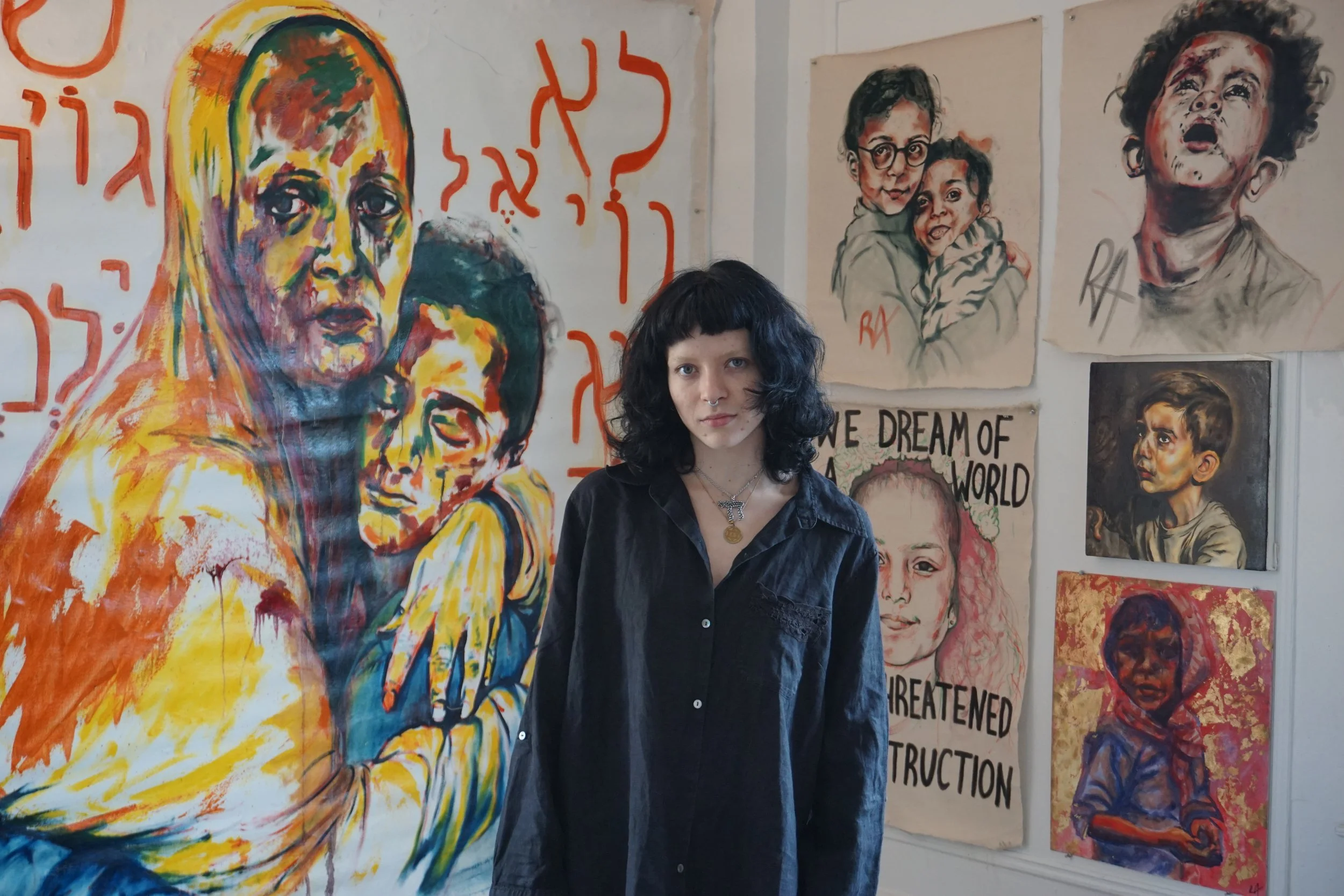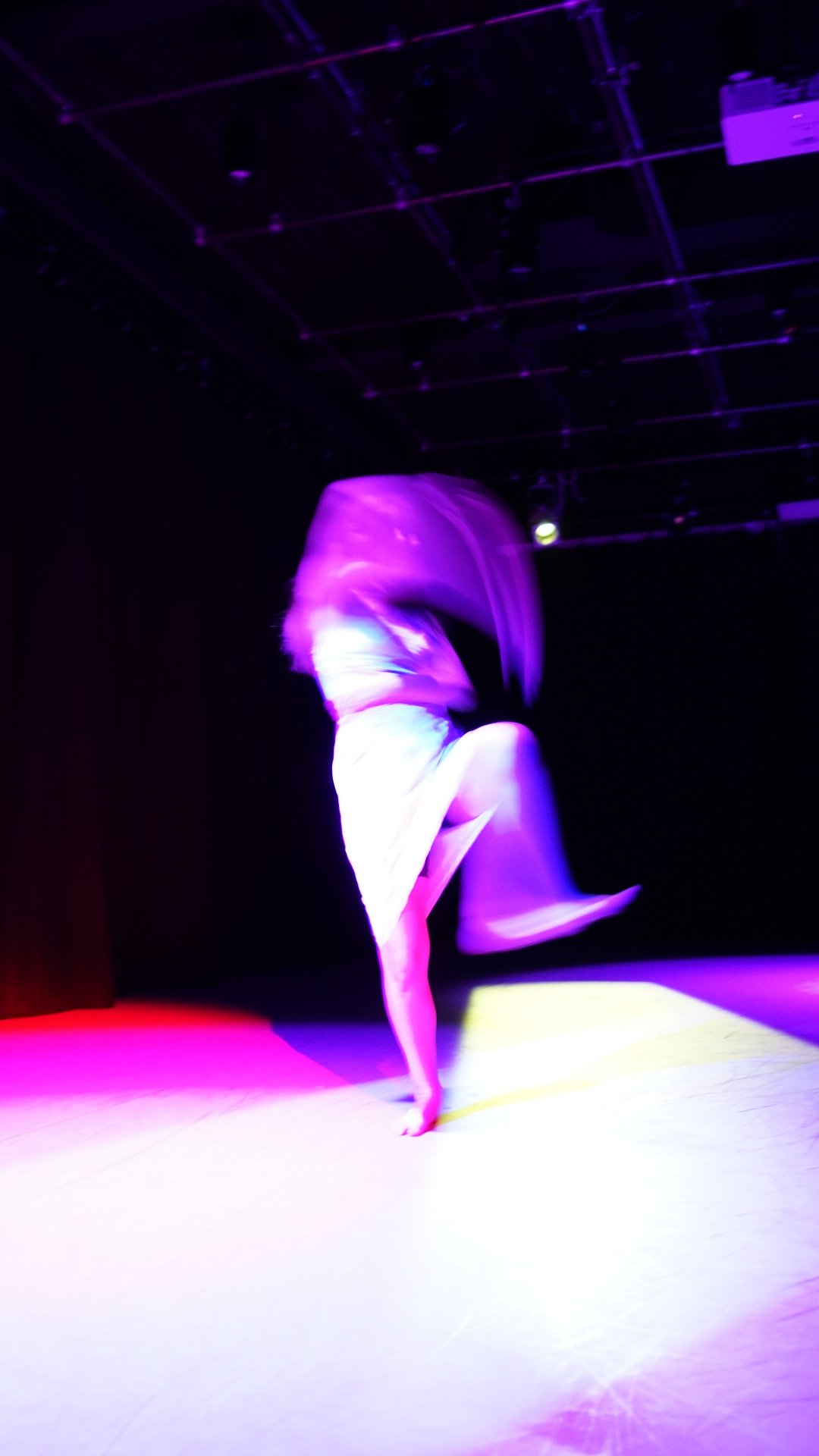Feature by Sahai John
Photos by Moksha Akil
Liz Radway is a senior at Columbia College studying dance, computer science and math. She enjoys glancing into the future as she experiments with motion capture technology and the mechanization of the body through dance and choreography. Liz spoke with me about the notion of the body as architecture, the future of dance, and blue zones.
Liz met me in the lobby of her Ruggles dorm in a red checkered sweater, ripped blue jeans, and a pair of cow earrings. She welcomed me into her room where I sat on a soft pink couch tucked between her bed and the window. The bookshelf full of texts on dancers and computer science, a black and white mat with the same checkered pattern as her sweater, and small hanging disco balls that reflected rainbows onto my pants as the light from the window grazed them all made me feel immediately cozied into a world of Liz. She filled this oasis on Frat Row with the music of an Etta James soundtrack playing from a record player next to her book shelf. As I sat on her couch, waiting for her to bring our waters, I could picture Liz playing a song on this and dancing on the checkered mat, creating what might be the start of one of her mesmerizing pieces of choreography or improv… Liz lifted the needle from the record player, pausing the song, and began to tell me about her career in dance.
Liz started taking dance classes with her sister when her mom enrolled them both after finding out that there was a sibling discount. Since then, Liz tells me, “it's always been a part of my life.” She started choreographing professionally during covid. “I wanted to do things on my own terms,” she tells me, “that's when I started getting interested in choreography.” Recently, Liz has been choreographing pieces that experiment with the notion of the body as architecture. “It's something that I've been exploring this semester, as I've been exploring Trisha Brown's movement. Her idea of the body as architecture is something a little bit different than how I've been interpreting it and putting it to use for myself. For her, it's the notion of almost perfection within the body in its positionality. For me, it's the acceptance of positionality in the body and movement, on its own. It's something beautiful and artistic, it can tell stories and can be designed. I’m less interested in the idea of there being a right and wrong and more in the idea of occupying space in a way that tells meaning and is beautiful.”
I asked Liz what that process of choreographing pieces and telling stories through them looks like for her. “I definitely like to keep my work thematic so it has something the audience can cling on to and kind of interpret on their own. But I'm trying to stay away from rigid narratives.” For Liz’s full length works, she takes a phrase of choreography and builds from there to create a story that the audience can interpret. “I think different types of dance serve different purposes,” Liz explains. “The point of improv, for me, is just to have fun, get out some energy, move my body, take a step back from the day and just move around. With choreography, the point is to either get something across or, with some pieces, I feel like the dancers are just trying not to throw up through it. My piece [in CoLab’s ‘The Big Jam’] is definitely like that. There’s going to be a lot of heaving and hawing at the end but it’s so much fun.”
Liz also finds inspiration from working with other choreographers to explore different ways of performing her works and experimenting with different themes. She’s choreographed for Orchesis and Colab and, for her senior creative thesis, she has been working with David Dorfman to incorporate spoken word in her solo.
Liz also enjoys working with her friends to mesh their personal interests with dance. “My two friends, Katie and Abby, and I worked on a piece for The Movement lab Festival and it's very much narrative based in a fun, silly way. Last year, we did a piece centered around space exploration. And this semester… Do you know the blue zones?” Liz asks me. “They're these pockets of Earth where people live to be centenarians, like 100 year olds. We've been thinking about that a lot. Our piece [The Blue Zone] is focused on that. It's centered around the sea. I thought that was a fun little pun off the blue zone and it's also where the oldest life has been throughout the Earth's history.”
Leg
Through dances like these, Liz taps into her interest in creative technology as she explores the evolution of the world and intelligent systems. Liz is interested in generative choreography and machine learning generated improvisation. This has inspired her to create her own model that can generate improvisatory movement. She’s been using motion capture technology to collect data for this and “make some fun art with it.” In one of her performances, Liz straps on bands with glowing green sensors around her arms, legs, hips, and head and then dances. A white, robotic figure is projected onto a screen behind her, moving with her. As the figure rolls its automated hips and prances across the screen in the same expressive way that Liz moves through the space, her seemingly disparate interests in dance and computer science appear completely in sync.
“It definitely is where the future of dance has to head,” Liz tells me, explaining how creative technology has become more and more involved in the dance world. Liz enjoys being a part of this evolution in dance. “I think it's fun to just peek into what the world can be like. That's the way that I see a lot of AI generated stuff, moving with dance to replicate improvisation on stage and interact with it.”
I asked Liz what she foresees for her own evolution and future in dance. She explained to me that there wasn’t a single moment when she felt like she had found her passion in dance. “It's always been there. And I could never imagine my life without it.” Liz tried to take some space away from dance this summer and it made her realize that from then on she wants to soak it up as much as possible. “I have a very specific memory of being a freshman in high school and being like, ‘Oh my god, I have four more years left to dance here until it's college.’ I didn't know what the future of me in dance would look like at that point. I just remember being devastated and freaking out about what I would do in a post-dance life.” Liz explained to me that she’s still there a little bit, trying to figure out what the future holds for her in dance but feeling confident that she wants it to remain a part of her life in some way.
“I always want to keep dancing and I always want to keep choreographing,” She explains. “The economy right now is not really one that's geared towards supporting artists and dance is not really placed as a valued art form right now, at least financially. In terms of receiving any funding, I'm not really quite sure how to figure that out yet. But I think that dance in America is alive and well. And I think that there's a lot of places where it's occurring. And a lot of underground places too. In dance history, all of the new ideas have come from these underground places, and eventually percolated upwards.” Liz hopes to remain a part of the long history of dance and traverse these creative spaces.
Moving forward, Liz intends to keep challenging herself in dance and choreography by incorporating new mediums. Film is on the horizon for her next. “I haven't really stepped into that territory before, dancing or choreographing for film. I'm not really sure what that entails yet so that's something I want to explore.”
I used to dance when I was a lot younger and I’ve always found myself easily drawn to dance. Anytime I watch a really good dance performance or performer, I feel a little tug at that younger me that makes me want to get up and dance. Watching Liz perform, I feel like I am being grabbed by the hand and pulled in to dance with her.
You can find clips of Liz’s incredible dances and information on where to watch her perform in person on her instagram.






































